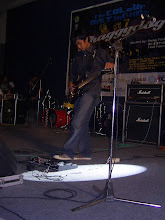
The Fender Stratocaster, often referred to as the Strat, is a model of electric guitar designed by Leo Fender, George Fullerton and Freddie Tavares in 1954, and manufactured continuously to the present. It is a double-cutaway guitar, with an extended top horn for balance while standing. The Stratocaster has been used by many leading guitarists, and thus can be heard on many historic recordings. Along with the Gibson Les Paul, Gibson SG, and the Fender Telecaster, it is one of the most common and enduring models of electric guitar in the world. The design of the Stratocaster has transcended the field of music to rank among the classic industrial designs of all time; examples have been exhibited at major museums around the world.[7]
In its original form, the Stratocaster was offered only in a 2-color sunburst finish, together with a solid one-piece maple neck with 21 frets, black dot inlays and Kluson machine heads. The single-ply, 8-screw hole white pickguard was a unique concept that allowed all of the guitar's electronic components - except the recessed jack plate - to be mounted on one easy-to-remove surface. Subsequent Stratocaster designs (by both Fender and other imitating companies) have ostensibly improved upon the original in usability and sound, but vintage Fender models are still often worth large amounts of money and some prefer the timbre of older models.
The Stratocaster has been widely copied; as a result, the term "Strat," although a trademark of Fender Musical Instrument Corporation, is often used generically when referring to any guitar that has the same general features as the original, regardless of manufacturer.
The Stratocaster's radically sleek, contoured body shape (officially referred to by Fender as the "Comfort Contour Body") was a marked difference to the flat, slab-like design of the Telecaster. The body features a unique curve on the upper back and a gradual curve at the front bottom, where the player's right arm rests. The one-piece maple neck's uniquely-shaped wide "dogleg"-style headstock again contrasted to the very narrow Telecaster's, which was designed shortly after World War II when wood supplies were less plentiful. The strings are anchored on a through-body pivot bridge attached with springs to a 'claw' in the bridge cavity on the back of the guitar. Original Stratocasters were shipped with five springs anchoring the bridge flat against the body. Players were able to remove the backplate covering the bridge, remove two of the springs and tighten the claw screws to allow the bridge to 'float,' with the pull of the strings in one direction countering the pull of the springs in the opposite direction. Once in the floating position, players can move the tremolo arm mounted on the bridge up or down to increase or decrease the pitch of the notes being played. Many players such as Eric Clapton, who dislike the instability of tuning of floating bridge Stratocasters, usually block the tremolo bridge by inserting a small wedge of wood in the front of the inertia block (the gap nearest the neck) and placing excessive spring tension on it to pull the fulcrum tight against this block.
The Stratocaster features three single coil pickups, with the output selected by a 3-way switch (the 5-way pickup selector, a standard feature since 1977)[8], allowed further tonal combinations and provided better switching stability; the "quacky" tone of the middle and bridge pickups, popularized by players such as Mark Knopfler, Bob Dylan, Eric Clapton and Robert Cray, can be obtained by using the pickup selector into positions 2 and 4). The neck and middle pickups are each wired to a tone adjustment knob, while the bridge pickup, which is slanted towards the high strings for a more trebly sound, has no tone control. On many modern Stratocasters, the first tone affects the neck pickup; the second tone affects the middle and bridge pickups; on some Artist Series models (Eric Clapton and Buddy Guy signature guitars), the first tone is a presence circuit which cuts (or boosts) treble and bass frequencies, affecting all the pickups; the second tone is an active midrange booster which boosts the midrange frequencies up to 25dB (or 12dB), giving a richer, fatter sound, almost identical to that of a full-sized humbucking pickup. The Elite Stratocaster of 1983 had similar features, except for the addition of three push-push buttons for pickup selection and a side-mounted jack socket. All three pickups' volume level is controlled by a single volume knob. The placement of the knobs allowed for relatively easy manipulation of the sound with the right hand while playing. The Stratocaster is noted for its bright, clean and 'twangy' sounds. Its sound quality is mainly determined by the dryness of its wood. Its wood is very dry and was dried in heated storage for three to six months before final precision cutting. The neck pickup has a mellower, fuller and louder sound compared to the brighter and sharper tone of the bridge pickup. The middle pickup provides a sound somewhere between the two. Typically, the neck pickup is used for rhythm playing, while the bridge pickup is used for lead work.

No comments:
Post a Comment